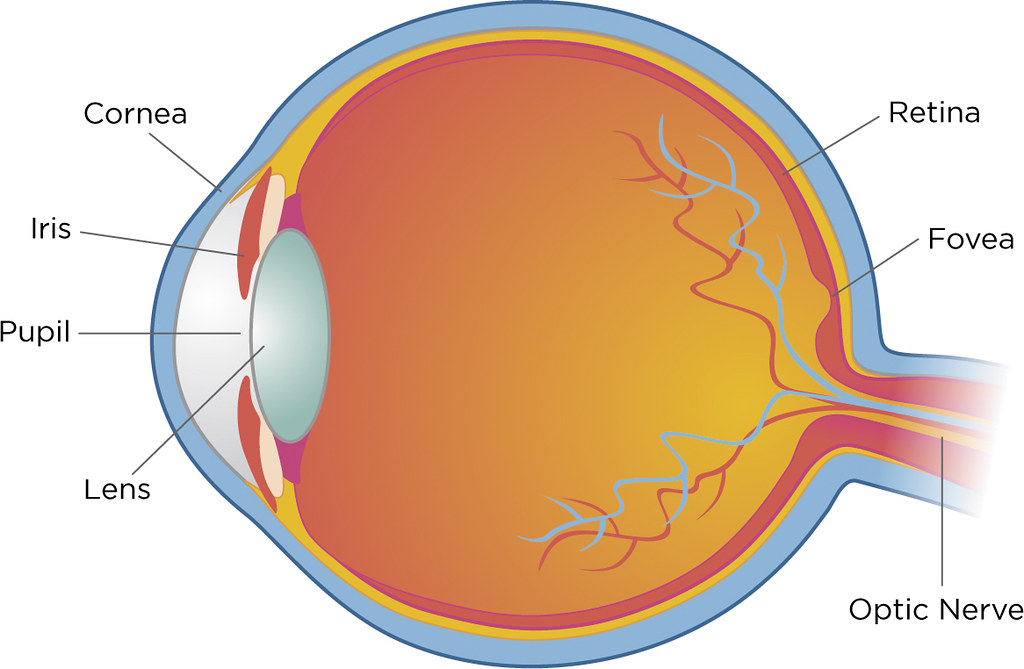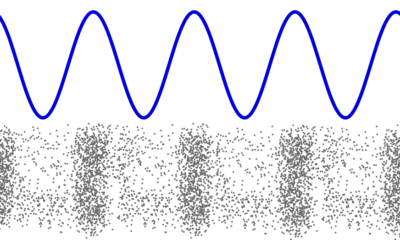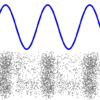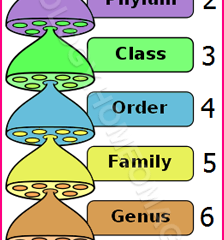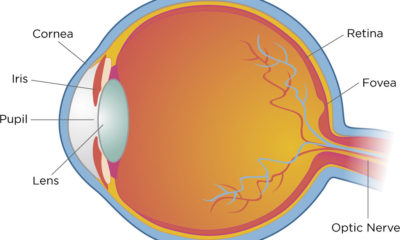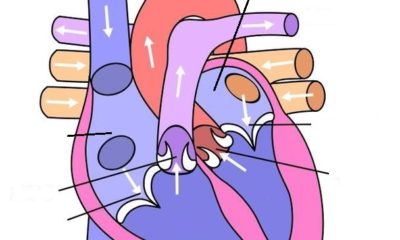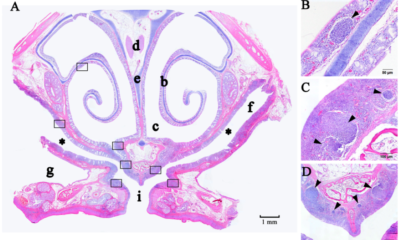Physics
Human Eye and The Colourful World
1. Human Eye. The human eye is like a camera. It refracts light thorough a natural convex lens made of transparent living material and enables us to see things around us. The salient features regarding construction and working of the human eye are:
Eyeball. The eyeball is approximately spherical in shape with a diameter of 2.3 cm.
Cornea is a transparent thin membrane on the front surface of the eyeball through which light enters the eye. Most of the refraction for the light rays entering the eye occurs at the outer surface of the cornea. Cornea is known as the window or aperture of the eye.
Pupil regulates and controls the amount of light entering the eye.
Iris is a dark circular muscular diaphragm located behind the cornea. It controls the size of the pupil and forms the variable aperture system of the eye. The colour of an eye depends on the colour of the pigments in the iris.
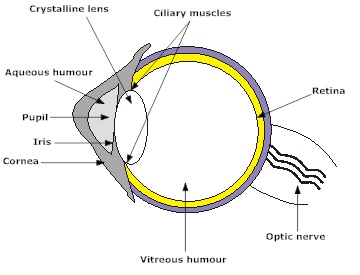
Lens- The eye lens forms an inverted real image of the object on the retina. The crystalline lens is held in position by ciliary muscles. It provides the finer adjustment of focal length required to focus objects at different distances on the retina.
Retina is a delicate membrane having large number of light-sensitive cells. It forms the inside surface of the rear part of the eyeball where the light entering the eyes is focused. The light-sensitive cells of the retina get activated upon illumination and generate electrical signals.
Optic nerves transmit the signals for vision. The electrical signals generated on the retina are sent to the brain via the optic nerves. The brain interprets these signals, and finally processes the information so that we perceive objects as they are.
2. Persistence of Vision. The ability of an eye to continue to see the image of an object for a very short duration even after the removal of the object, is called persistence of vision. In human eye, vision persists for 1/16th of a second after the removal of the object.
3. How do we see Colours? The retina of our eye has a large number of light sensitive cells. Rod shaped and cone shaped. The rod shaped cells of our retina respond to the intensity of light. The cone shaped cells of our retina respond to colours.
4. Colour Blindness. Colour blindness is that defect of the eye due to which a person is unable to distinguish between certain colours.
5. Accommodation. The ability of an eye to focus both near and distant objects by changing the focal length (or converging power) of its lens is called accommodation. A normal eye has a power of accommodation which enables objects as far as infinity and as close as 25 cm to be focused on the retina.
The ciliary muscles play an important role in accommodation. They are most relaxed while focusing the distant objects (at infinity) and most contracted while focusing the objects at near point of the eye.
6. Range of Vision of a Normal Human Eye. The range of vision of a normal human eye is from infinity to about 25 centimeters.
7. Far Point. The farthest point from the eye which can be seen clearly is known as the “far point” of the eye. The far – point of a normal eye is at infinity.
8. Near Point or Least Distance of Distinct Vision. The smallest distance at which the eye can see the objects clearly without strain is called the near point of the eye or the least distance of distinct vision. For a young adult with normal vision it is abut 25 cm.
9. Functioning of pupil. We are not able to see objects clearly for some time on entering from bright light to a room with dim light. After sometime, however, we may be able to see things in the dim-lit room. The pupil of an eye acts like a variable aperture whose size can be varied with the help of the iris. When the light is very bright, the iris contracts the pupil to allow less light to enter the eye. However, in dim light the iris expands the pupil to allow more light to enter the eye. Thus, the pupil opens completely through the relaxation of the iris.
10. Why do we have two eyes for vision and not just one?
(i) It gives a wider field of view. A human being has a horizontal field of view of about 1500 with one eye and of about 1800 with two eyes.
(ii) The ability to detect faint objects is enhanced with two eyes instead of one.
(iii) Because our eyes are separated by a few centimeters, each eye sees a slightly different image. Our brain combines the two images into one, and thus provides three- dimensional perception of the objects (stereopsis).
11. Why do some animals have their two eyes positioned on opposite sides of their heads?
To give the widest possible field of view.
12. Eye Defects. Some common optical defects of the eye are :
1. Myopia (Short-sightedness or Near-sightdness)
2. Hypermetropia (Ling-sightedness or Far-sightedness)
3. Presbyopia
| Defect | Description | Cause | Remedy |
| 1. Myopia or Short Sightedness | (i) Eye can see distinctly Only the near objects, (ii) Far point of eye comes closer than infinity. | (i) Excessive curvature of the eye lens, or (ii)Elongation of the eyeball. | Using a concave lens of suitable power which brings the image back on to the retina As a result, focal length of eye lens decreases. Rays from ¥ focus at a point in front of the retina. |

| 2. Hypermetropia or far sightedness | (i) Eye can see distinctly only the far off objects (ii) Near point of eye shifts away from the eye. | (i) Focal length of the eye is too long, or (ii) Eye ball has become too small | Using a convex lens of suitable power which provides the additional focusing power required. As a result, focal length to form the image on the retina of eye lens increases. Rays from near point focus at a point at the back of retina. |

| 3. Presbyopia | (i) Image of nearby objects appears blurred (ii) Power of accommodation of the eye decreases with old age. | Gradual weakening of the ciliary muscles and the loss of flexibility of the eye lens with age. | By using a converging lens (specs) for reading and other close work. |
Sometimes, a person may suffer from both myopia and hypermetropia and may require bi-focal lenses. A common type of bi-focal lenses consists of both concave and convex lenses. The upper portion consists of a concave lens (to correct myopia) for distant vision while the lower portion consists of a convex lens (to correct hypermetropia) to facilitate near vision.
These days, it is possible to correct the refractive defects with contact lenses or through surgical interventions.
13.Cataract develops when the eye-lens of a person becomes hazy (or even opaque) due to the formation of a membrane over it. It causes partial or complete loss of vision. The vision of the person can be restored thorugh cataract surgery.
14. Prism is any refracting medium which is bounded by intersecting planes (in contrast to parallel planes as in the case of a rectangular slab). A triangular glass prism (usually called ‘glass prism’) has two triangular faces and three rectangular lateral surfaces which are inclined to each other.
The two rectangular faces through which refraction takes place are called the refracting faces, the third face is known as the base of the prism. The angle between its two lateral faces is called the angle of the prism.
15. Refraction of Light Through a Prism. In refraction through a glass slab, the emergent ray is parallel to the incident ray while in refraction through a prism, the emergent ray is deviated from its original direction since the refracting surfaces of the prism are not parallel.
The incident ray of light going from air (rarer medium) into the glass (denser medium) undergoes refraction and is bent towards the normal. The refracted ray thus bends towards the base of the prism.
When this refracted ray travels out of the glass prism (denser medium) into the air (rarer medium), it undergoes refraction again and is bent away from the normal. This bending of the emergent ray is again towards the base of the prism.
The angle between incident ray and emergent ray is called angle of deviation.
16.Dispersion. The splitting up of white light into seven colours on passing through a transparent medium like a glass prism is called dispersion of light.
The dispersion of white light occurs because the angle of refraction (or angle of bending) of different colours is different when passing through the glass prism. The red colour is deviated least, violet colour is deviated the maximum. Thus the rays of each colour emerge along different paths and thus become distinct.
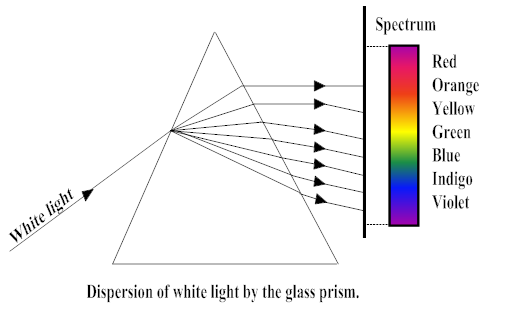
17. Spectrum. The band of the coloured components of a light beam is called its spectrum. The sequence of colours in the spectrum of white light is Violet, Indigo, Blue, Green, Yellow, Orange and Red (remembered as acronym VIBGYOR).
18. White Light. Any light gives a spectrum similar to that of sunlight is known as white light.
19. Sunlight is made up of seven colours (Newton’s experiment). Newton tried to split the colours of the spectrum of white light further by using another similar prism but could not get any more colours. While observing the dispersion of white light through a glass prism, if a second identical prism is placed in an inverted position w.r.t. the first prism, recombination of the spectrum takes place. A beam of white light emerges from the other side of the second prism. This observation gave Newton the idea that he sunlight is made up of seven colours.
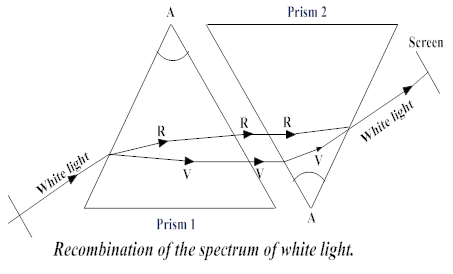
20. Rainbow is a natural spectrum appearing in the sky after a rain shower. It is caused by the dispersion of sunlight by tiny water droplets present in the air.
Some important points are:
(i) A rainbow is always formed in a direction opposite to that of the Sun.
(ii) Water droplets refract and disperse the incident sunlight, then reflect it internally and finally refract it again as it comes out of the raindrop.
(iii) Different colours reach the observer’s eye due to the dispersion and internal reflection of light.
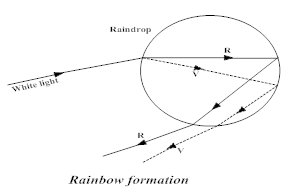
21. Atmospheric Refraction. The cooler air layers of the atmosphere are optically denser than the warmer layers which are optically rarer. The refraction of light caused by the earth’s atmosphere (having air layers of different optical densities) is called atmospheric refraction.
Some of the optical phenomenon which occur due to atmospheric refraction are :
(i) Mirage. Mirage is an optical illusion due to which we see a layer of water at a short distance ahead of us in a desert (or on a road) on a very hot day, when actually there is no water at all. Mirage is produced by the total internal reflection of light (in the upward direction) caused by atmospheric refraction.
(ii) Twinkling of Stars. When the light coming from a star enters the earth’s atmosphere, it undergoes refraction due to the varying optical density of air at various altitudes. Since the atmosphere bends starlight towards the normal, the star appears slightly higher than its actual position. Further, the continuously changing physical conditions of atmosphere lead to refraction of light by different amounts from one moment to the next. As the path of the rays goes on varying slightly, the apparent position of the star fluctuates and the amount of starlight entering the eye flickers giving the twinkling effect.
Unlike stars, the planets don’t twinkle. The planets are much closer to the earth, and are thus seen as extended sources. If we consider a planet as a collection of a large number of point-sized sources of light, the total variation in the amount of light entering our eye for all the individual point-sized sources will average out to be zero, thereby nullifying the twinkling effect.
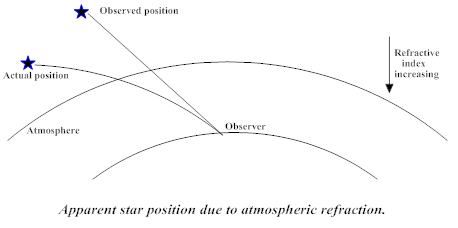
(iii) Advance sunrise and delayed sunset. The sun can be seen two minutes before actual sunrise and two minutes after the actual sunset because of atmospheric refraction. When the sun is slightly below the horizon, the sun’s light coming from less dense air to more dense air is refracted downwards as it passes through the atmosphere. The sun thus appears to be raised above the horizon when actually it is below the horizon.
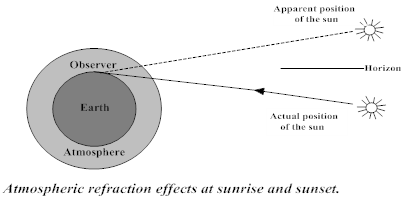
The apparent flattening of the sun’s disc at sunrise and sunset is also due to atmospheric refraction.
22. Scattering of Light. Scattering is the bouncing off light rays by atoms/molecules of the medium through which it is propagating. Amount of scattering is inversely proportional to the fourth power of the wavelength of light (electromagenetic radiation).
23. Tyndall Effect. The scattering of light as it passes through a medium containing small particles is called Tyndall effect. Some situations where Tyndall effect can be observed are :
(i) When a fine beam of sunlight enters a smoke-filled room through a small hole, the scattering of light makes the small particles visible.
(ii) When sunlight passes through a canopy of a dense forest, tiny water droplets in the mist scatter light.
The colour of the scattered light depends on the size of the scattering particles. Very fine particles scatter mainly blue light while particles of larger size scatter light of longer wavelengths. If the size of the scattering particles is large enough, then , the scattered light may even appear white.
24. Effects of Scattering of Light
(a) Blue Colour of the Sky. When white light from the sun passes through the earth’s atmosphere, the fine particles in air scatter the blue colour (shorter wavelength) more strongly than red. The scattered blue colour enters our eyes and the sky appears blue.
(b) Sun appears reddish at sunset and sunrise.
At sunrise and sunset, when the sun is near the horizon, the light rays have to travel a longer distance through earth’s atmosphere than when the sun is overhead. Thus due to having highest wave length only red colour waves are able to reach our eyes and lot of blue colour gets scattered away and the sun appears reddish.
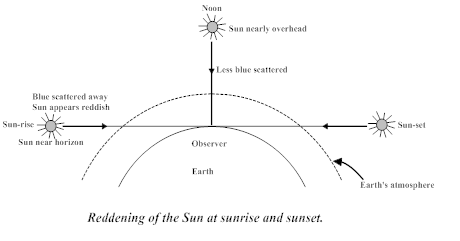
(c) White colour of clouds. The clouds consist of dust particles and water droplets. Their size is very large as compared to the wavelength of the incident light from the sun. So there is very little scattering of light. Rather, all wavelengths are scattered nearly equally. Hence the light which we receive through the clouds has all the colours of light. As a result of this, the clouds appear white.
(d)Danger Signals are red in colour. Due to its longer wavelength, red colour is least scattered by fog or smoke. Thus, the signal is visible in the same colour from large distances.


